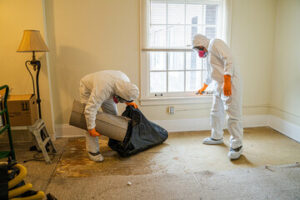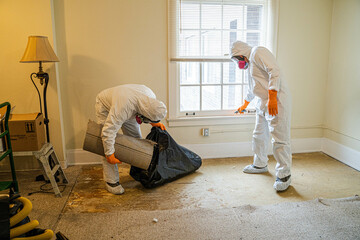Water damage is a huge problem for property owners. In addition to spreading toxic mold spores and ruining furniture and electronics, it can cause foundation cracks and other structural issues.
Water damage can be caused by anything from a torrential rainstorm to clogged gutters. It often goes unnoticed and can lead to serious (and expensive) problems in the long run.
If you are thinking about buying a new home, it’s important to look for signs of water damage. This can help you avoid wasting money on a home that will need costly repairs down the road. You can also make a good impression on the seller by pointing out these problems ahead of time, so they have more time to fix them before you move in.
Water stains are one of the first signs that a house may have water damage. These marks usually appear on the ceiling or walls and are yellowish in color. They are caused by a buildup of moisture in the walls or ceiling that leads to deterioration of the material.
Other signs of water damage include the musty odor that is often associated with mold. This smell is caused by a combination of things, including the presence of moisture and the lack of air circulation in the area. If you notice this odor, it is likely that mold and other harmful substances are present in the home.
Another sign of water damage is the appearance of dark spots on the walls. This happens when the drywall gets wet and begins to expand. This can lead to cracking in the walls. If the drywall is not repaired, it can eventually fall off the wall and create a hole in the structure of the house.
If you notice any of these signs, you should have a professional inspection done. The inspector can tell you whether the house is safe to buy or if it needs extensive repair work before you move in. You can then decide to continue with the purchase or strike it from your list of potential homes.
If the house has severe water damage, you may be able to negotiate a lower price or find an alternative location for the property. Water damage is a serious problem that can affect the value of your home, so it’s important to take precautions and address it as soon as possible. If you’re not sure how to identify water damage, consider getting a few estimates from companies that specialize in this service.
Preventing water damage
Whether it is caused by natural disasters or manmade accidents, extensive water damage in your home can be devastating. However, vigilance and routine maintenance can help you avoid the risk. Understanding your home’s plumbing system, inspecting your home’s exterior, addressing leaks and other problems, protecting your home in cold weather, and using technology to monitor the status of your property are all effective ways to prevent water damage.
The first step is knowing how to identify and shut off your home’s water supply. A severe water leak or rupture can occur in as little as a few minutes and require quick action to mitigate the damage. Ensure that you and all members of your family know where the stopcock is and how to properly shut off the water to your home.
You should also keep an eye on your water bill and pay attention to any unexplained spikes in usage. A sudden and unexpected increase in your water usage may indicate a leak or a burst pipe. You should regularly check around your house for signs of moisture, such as bubbled paint and wallpaper, damp wood framing, or rotting walls.
If you notice any of these symptoms, investigate right away and repair any problems you find. Leaving any issues unchecked will likely lead to mold or mildew growth, which are common causes of water damage and can be costly to repair.
Leaks and faulty appliances are among the leading causes of home water damage. To help prevent these problems, you should regularly inspect and maintain your appliances according to the manufacturer’s directions. Additionally, you should replace hoses on a regular basis and make sure that they are disconnected when not in use to prevent leaks and ruptures.
You should also regularly check the gutters and downspouts on your home’s exterior. Debris in gutters and downspouts can block the flow of rainwater, causing it to back up into the home. This can lead to clogged gutters, rusty or damaged downspouts, and a flooded basement.
Identifying water damage
When water damage is spotted during home inspections, it is essential to address the problem immediately. If it is left untreated, the water can cause mold and mildew growth, which can rot wood structures and lead to serious health issues. Water damage can also result in warped walls and floors.
A home inspector can look for signs of water damage during a pre-purchase inspection. This can prevent the purchase of a house with water damage, which would require expensive repairs and may even make the property unsafe for living. It is not always easy to identify water damage, though, as it can be hidden behind walls and in floor cavities.
One of the most common causes of water damage is plumbing issues. Leaky pipes or malfunctioning appliances like water heaters, washing machines, and dishwashers can all lead to flooding and other problems. The best way to find out if a home has water damage is to check for obvious signs, such as dampness or sagging ceilings.
You can also use a flashlight to investigate areas where pipes are concealed. Be sure to check under sinks and in toilet rooms for signs of leaks, rust, or corrosion. Also, run your hands over the surfaces of walls and floors to feel for any dampness or a soft texture.
Water rings on walls and ceilings are another indicator of previous water damage. The more rings, the older the water damage. The presence of these marks indicates that the surface has been wet, dried, and wet again many times over a period of time.
Musty odors are also an indication of water damage, says Plumb Time Plumbing and Drain Services. If a musty smell is present, it can indicate the presence of mold and mildew, which are harmful to human health. A musty odor is also indicative of the fact that moisture has been trapped in the area for a long period of time, causing rot and mold.
Category 1 water damage is considered clean, meaning it does not contain contaminants or pollutants that could harm humans. Category 2 water damage, on the other hand, contains toxins and is often described as “black water damage.” It can lead to serious illness if it comes into contact with your skin or lungs.
Repairing water damage
It’s essential to take swift action to repair water damage before it worsens. This can prevent mold and mildew growth as well as structural damage to the property.
The first step in repairing water damage is to find and stop the source of the leak. This can be done by shutting off the water or calling a professional. It is also important to remove all standing water from the property. This can be done by using large, industrial-type wet vacs and pumps. It is also a good idea to use fans to help dry out the affected areas of the property.
Once the source of the leak is stopped, the next step is to assess the damage. The Institute of Inspection, Cleaning, and Restoration Certification (IICRC) divides water damage into categories based on the contaminants found in the water. Category 1 water is considered clean and poses no long-term health risks to people. This type of water comes from broken supply lines and pipes, as well as overflowing bathtubs or sinks.
Class 2 water is contaminated with dangerous materials and poses a health risk to humans. This type of water is often caused by sewage or chemical spills. It can also be the result of untreated flooding from storms or bodies of water. It is necessary to wear personal protective equipment when working with this type of water.
Category 3 water is the most severe and contains dangerous chemicals, bacteria, and other materials that pose serious health risks. This type of water may be the result of a flooded basement or a swollen river. It is necessary to wear protective clothing and use specialized tools when working with this type of water.
Home buyers should always check to see if the house they are considering has any water damage. It is a good idea to ask the seller if they have any insurance policies in place that cover the cost of making repairs for water damage. The average home buyer should budget between $500 and $3,000 to make any needed repairs for water damage.

